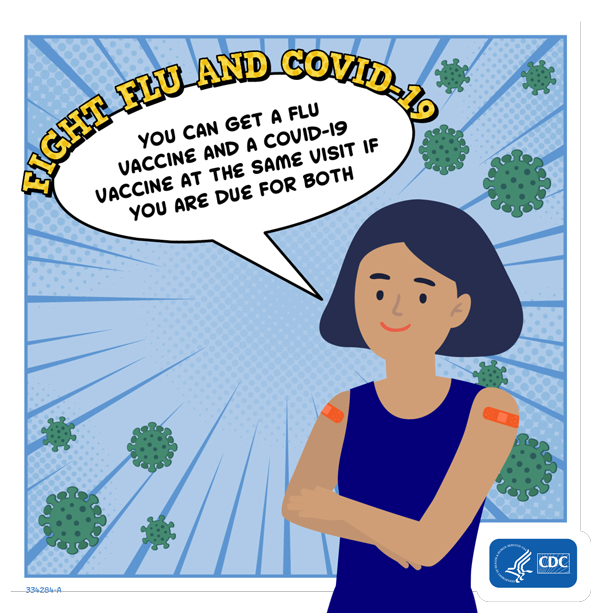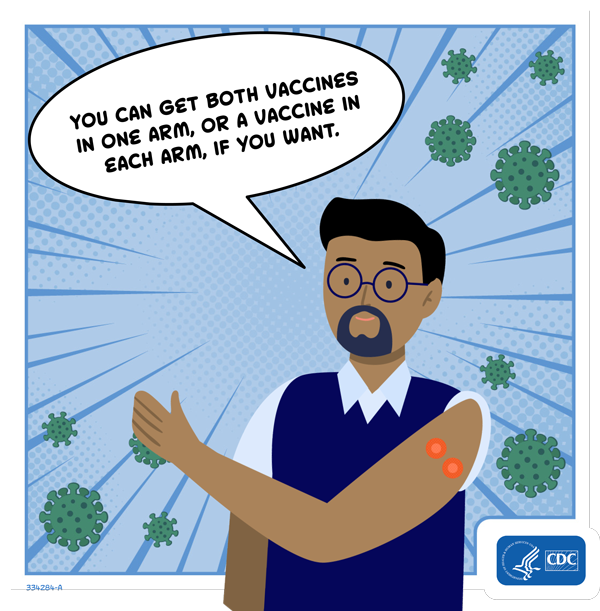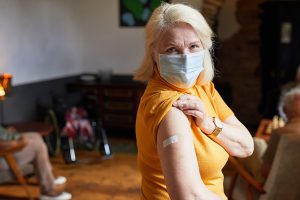Information for the 2023-2024 Flu Season
Updates to the Advisory Committee on Immunization Practices (ACIP) Flu Vaccine Recommendations for the 2023-2024 season
A couple of things are different for the 2023-2024 influenza (flu) season:
- The composition of flu vaccines has been updated. Flu vaccines for the U.S. 2023-2024 season will contain the following:
Egg-based vaccines
-
-
- an A/Victoria/4897/2022 (H1N1)pdm09-like virus; (Updated)
- an A/Darwin/9/2021 (H3N2)-like virus;
- a B/Austria/1359417/2021 (B/Victoria lineage)-like virus; and
- a B/Phuket/3073/2013 (B/Yamagata lineage)-like virus.
-
- Cell- or recombinant-based vaccines
-
- an A/Wisconsin/67/2022 (H1N1)pdm09-like virus; (Updated)
- an A/Darwin/6/2021 (H3N2)-like virus;
- a B/Austria/1359417/2021 (B/Victoria lineage)-like virus; and
- a B/Phuket/3073/2013 (B/Yamagata lineage)-like virus.
- These recommendations include one update compared to the 2022-2023 U.S. flu vaccine composition. The influenza A(H1N1)pdm09 vaccine virus component was updated for egg-based and cell- or recombinant-based flu vaccines.
-
- People with egg allergy may get any vaccine (egg-based or non-egg-based) that is otherwise appropriate for their age and health status. Previously, it was recommended that people with severe allergy to egg (those who have had any symptom other than hives with egg exposure) be vaccinated in an inpatient or outpatient medical setting. Beginning with the 2023-2024 season, additional safety measures are no longer recommended for flu vaccination of people with an egg allergy beyond those recommended for receipt of any vaccine, regardless of the severity of previous reaction to egg. All vaccines should be given in settings where allergic reactions can be recognized and treated quickly.
Projected U.S. Flu Vaccine Supply for the 2023-2024 Season
- Vaccine manufacturers have projected that they will supply the United States with as many as 156.2 million to 170 million doses of influenza vaccines for the 2023-2024 season. These projections may change as the season progresses.
- All flu vaccines for the 2023-2024 season will be quadrivalent (four-component).
- Most will be thimerosal-free or thimerosal-reduced vaccines (91%), and about 21% of flu vaccines will be egg-free.
- The latest information on total distribution of influenza vaccine doses for the 2023-2024 season is available.
Updates to U.S. Flu Surveillance Methods for the 2023-2024 Season
Starting with the 2023-2024 influenza season, the percent of deaths with influenza listed on the death certificate will be displayed in FluView. P&I (pneumonia and/or influenza) no longer measures the impact of influenza in the same way it had prior to the COVID-19 pandemic, and the PIC (pneumonia, influenza and/or COVID) measure is largely being driven COVID-19 activity making it difficult to monitor the impact of influenza using that measure. Although monitoring influenza-only coded deaths will underestimate the full impact of influenza mortality, this measure allows for tracking trends in the impact of influenza on mortality and is not as influenced by COVID-19 as the other two measures. More information about U.S. influenza surveillance is available.
Take time to get a flu vaccine
- CDC recommends a yearly flu vaccine as the first and most important step in protecting against flu viruses.
- Flu vaccines help to reduce the burden of flu illnesses, hospitalizations and deaths on the health care system each year. (Read more about flu vaccine benefits.)
- This season, all flu vaccines will be designed to protect against the four flu viruses that research indicates will be most common. (Visit Vaccine Virus Selection for this season’s vaccine composition.)
- Everyone 6 months and older should get an annual flu vaccine, ideally by the end of October. Learn more about vaccine timing.
- Vaccination of people at higher risk of developing serious flu complications is especially important to decrease their risk of severe flu illness.
- People at higher risk of serious flu complications include young children, pregnant people, people with certain chronic health conditions like asthma, diabetes or heart and lung disease, and people 65 years and older.
- Vaccination also is important for health care workers, and other people who live with or care for people at higher risk to keep from spreading flu to them. This is especially true for people who work in long-term care facilities, which are home to many of the people most vulnerable to flu.
- Children younger than 6 months are at higher risk of serious flu illness but are too young to be vaccinated. People who care for infants should be vaccinated instead.
Take everyday preventive actions to stop the spread of germs
- Take everyday preventive actions that are recommended to reduce the spread of flu.
- Avoid close contact with people who are sick.
- If you are sick, limit contact with others as much as possible to keep from infecting them.
- Cover coughs and sneezes.
- Cover your nose and mouth with a tissue when you cough or sneeze. Throw the tissue in the trash after you use it.
- Wash your hands often with soap and water. If soap and water are not available, use an alcohol-based hand rub.
- Avoid touching your eyes, nose, and mouth. Germs spread this way.
- Clean and disinfect surfaces and objects that may be contaminated with viruses that cause flu.
- For flu, CDC recommends that people stay home for at least 24 hours after their fever is gone except to get medical care or other necessities. Fever should be gone without the need to use a fever-reducing medicine. Note that the stay-at-home guidance for COVID-19 may be different. Learn about some of the similarities and differences between flu and COVID-19.
Take flu antiviral drugs if your doctor prescribes them
- If you are sick with flu, antiviral drugs can be used to treat your illness.
- Antiviral drugs are different from antibiotics. They are prescription medicines (pills, liquid or an inhaled powder) and are not available over-the-counter.
- Flu antiviral drugs can make flu illness milder and shorten the time you are sick. They may also prevent serious flu complications. For people with higher risk factors [308 KB, 2 Pages], treatment with an antiviral drug can mean the difference between having a milder illness versus a very serious illness that could result in a hospital stay.
- Studies show that flu antiviral drugs work best for treatment when they are started within 2 days of getting sick, but starting them later can still be helpful, especially if the sick person has a higher risk factor or is very sick from flu.
- If you are at higher risk from flu and get flu symptoms, call your health care provider early so you can be treated with flu antivirals if needed. Follow your doctor’s instructions for taking this drug.
Flu symptoms include fever, cough, sore throat, runny or stuffy nose, body aches, headache, chills and fatigue. Some people also may have vomiting and diarrhea. People may be infected with flu and have respiratory symptoms without a fever. Visit CDC’s website to find out what to do if you get sick with flu. Learn about some of the similarities and differences between flu and COVID-19, and the difference between flu and the common cold.
Getting a Flu Vaccine and a COVID-19 Vaccine at the Same Time



You can get both vaccines in one arm (at least an inch apart), or a vaccine in each arm. It’s up to you.
For certain flu vaccines that might be more likely to cause symptoms where they are injected, separate arms are recommended if possible.
You can get a flu vaccine and a COVID-19 vaccine at the same visit if you are due for both vaccines. This is an option.
What is coadministration?
Coadministration of vaccines refers to giving or getting more than one vaccine during a visit. This is common clinical practice. While there are some exceptions, many vaccines can be given at the same visit.
Why would a health care provider encourage people to get both vaccines at the same time?
Giving more than one vaccine at a visit, also called “coadministration” is common medical practice and is recommended. The idea is to get people up to date on all the vaccines they are due for at one visit. This can ensure that people get all of their vaccines, in case they are not able to return visit for additional vaccinations at a later time.
Can flu vaccines and COVID-19 vaccines be coadministered?
Yes, flu vaccines and COVID-19 vaccines can be given at the same visit if you are due for both vaccines.
Is it safe to get a flu vaccine and a COVID-19 vaccine at the same time?
Studies conducted throughout the COVID-19 pandemic indicate that it is safe to get both a flu vaccine and a COVID-19 vaccine at the same visit. A CDC study published this summer showed people who got a flu vaccine and an mRNA COVID-19 booster vaccine at the same time were slightly more likely (8% to 11%) to have reactions including fatigue, headache, and muscle ache than people who only got a COVID-19 mRNA booster vaccine, but these reactions were mostly mild and went away quickly. The findings of this study are consistent with safety data from clinical trials that did not find any safety concerns with giving both vaccines at the same time.
Why should I get a flu vaccine and a COVID-19 vaccine at the same visit?
Getting both vaccines at the same time if you are due for both is an option for consumers. Some people might prefer to get their vaccines at one time. This might be more convenient than having two separate visits.
If I get both vaccines at the same visit, where should I get them?
CDC has guidance for health care providers on giving more than one vaccine at the same visit. For flu and COVID-19 vaccines, you can either get both vaccines in the same arm (at least an inch apart), or you can get them in different arms. Either is okay. The high-dose (Fluzone High-Dose Quadrivalent) or adjuvanted flu vaccine (Fluad Quadrivalent) may be more likely to cause side effects compared to standard dose flu vaccines. You may want to get these high-dose flu vaccines in different arms than the arm receiving a COVID-19 vaccine to reduce side effects in one arm.
If I decide to wait between getting my flu vaccine and a COVID-19 vaccine, is there a recommended waiting time between vaccines?
No, there’s no recommended waiting time between getting a flu vaccine and a COVID-19 vaccine.
I don’t have a primary care provider. Where can I get a flu vaccine?
If you don’t have a health care provider you regularly see, you can find flu vaccines at many places, including health departments and pharmacies.
Information courtesy of the Centers for Disease Control and Prevention. For more Q&As, visit https://www.cdc.gov/flu/season/faq-flu-season-2023-2024.htm







